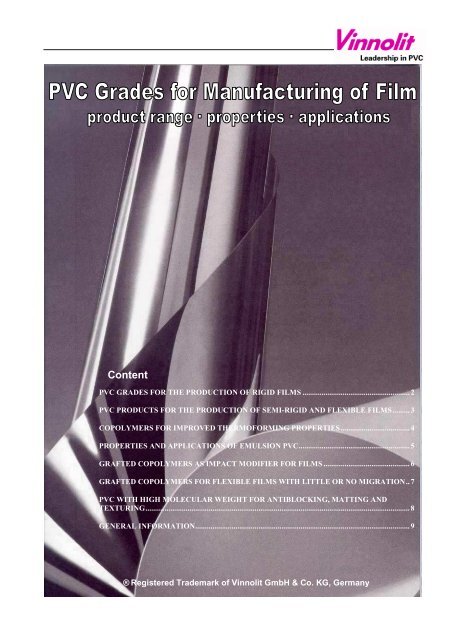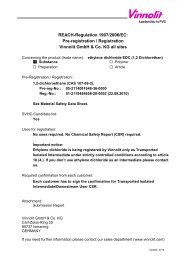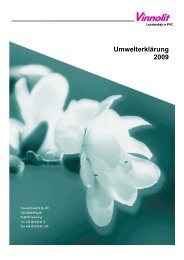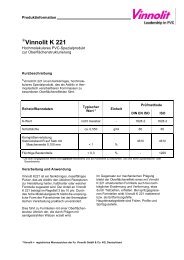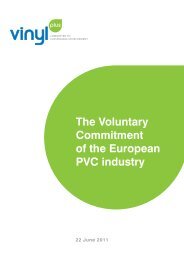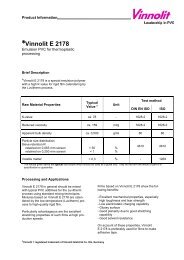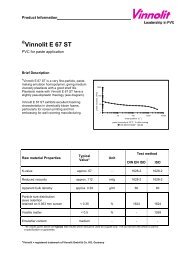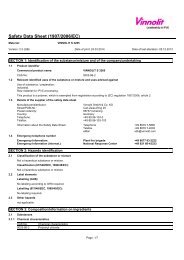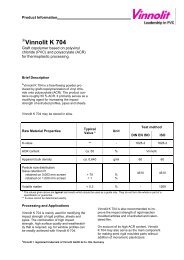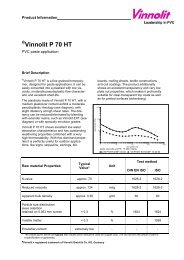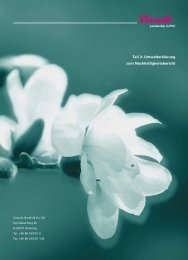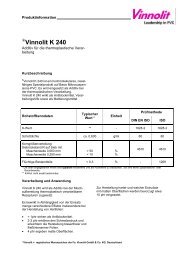PVC Products for the Production of Rigid Films - Vinnolit
PVC Products for the Production of Rigid Films - Vinnolit
PVC Products for the Production of Rigid Films - Vinnolit
- No tags were found...
Create successful ePaper yourself
Turn your PDF publications into a flip-book with our unique Google optimized e-Paper software.
Content<strong>PVC</strong> GRADES FOR THE PRODUCTION OF RIGID FILMS ........................................................ 2<strong>PVC</strong> PRODUCTS FOR THE PRODUCTION OF SEMI-RIGID AND FLEXIBLE FILMS......... 3COPOLYMERS FOR IMPROVED THERMOFORMING PROPERTIES.................................... 4PROPERTIES AND APPLICATIONS OF EMULSION <strong>PVC</strong>.......................................................... 5GRAFTED COPOLYMERS AS IMPACT MODIFIER FOR FILMS ............................................. 6GRAFTED COPOLYMERS FOR FLEXIBLE FILMS WITH LITTLE OR NO MIGRATION.. 7<strong>PVC</strong> WITH HIGH MOLECULAR WEIGHT FOR ANTIBLOCKING, MATTING ANDTEXTURING.......................................................................................................................................... 8GENERAL INFORMATION................................................................................................................ 9® Registered Trademark <strong>of</strong> <strong>Vinnolit</strong> GmbH & Co. KG, Germany
Page 2/9<strong>PVC</strong> <strong>Products</strong> <strong>for</strong> <strong>the</strong> <strong>Production</strong> <strong>of</strong> <strong>Rigid</strong> <strong>Films</strong>Examples <strong>for</strong> rigid films:Packaging, credit cards, pharmablister, adhesive tapes etc.® <strong>Vinnolit</strong> grade K valueDIN 53726Viscosity no.(cm 3 /g) DIN 53726Co/GraftcomponentBulk density(g/l)DIN 53466Typical applicationsS-<strong>PVC</strong>(Suspension <strong>PVC</strong>)E-<strong>PVC</strong>(Emulsion <strong>PVC</strong>)S 3160 60 89 - 570 Standard grade <strong>for</strong> rigid filmsE 2059 59 86 - 500Blending component <strong>for</strong> rigid films promotesfaster fusion and supports antistatic propertiesE 2078 78 159 - 460 Special grade <strong>for</strong> Luvi<strong>the</strong>rm processK 301 * * - 550 Antistatic agent <strong>for</strong> transparent, rigid filmsCopolymersS 3060/10S 3157/116057898010 % VAC11 % VAC620650Main or blending component <strong>for</strong> highly transparentrigid films to improve <strong>the</strong>rmo<strong>for</strong>mingper<strong>for</strong>manceVK 801K 707 E****50 % EVA50 % ACR570550Impact modifier <strong>for</strong> opaque or pigmented rigidfilms suitable <strong>for</strong> outdoor useGraftedCopolymersVK 710 * * 50 % ACR 650K 725 F * * 50 % ACR 500Impact modifier as described above with additionalrelease effectImpact modifier <strong>for</strong> articles with very low stresswhiteningand is suitable <strong>for</strong> exterior applicationsGrades <strong>for</strong>antiblocking,matting andK 240C 100 V**texturing K 221 * * - 590**--600630Antiblocking or matting agentTexturing agent, gives a sand-blasted or frostedeffect* cannot be determined exactly with common methods ® Registered Trademark <strong>of</strong> <strong>Vinnolit</strong> GmbH & Co. KG, GermanyVACEVAACRVinylacetateEthylen-vinylacetate-copolymerPolyacrylic rubber
Page 3/9<strong>PVC</strong> <strong>Products</strong> <strong>for</strong> <strong>the</strong> <strong>Production</strong> <strong>of</strong> Semi-<strong>Rigid</strong> and Flexible <strong>Films</strong>Examples <strong>for</strong> semi-rigid and flexible films:Ro<strong>of</strong>ing sheets, label films, insulating tapes, tarpaulins, artificial lea<strong>the</strong>r etc.® <strong>Vinnolit</strong> grade K valueDIN 53726Viscosity no.(cm 3 /g) DIN 53726GraftcomponentBulk density(g/l)DIN 53466Typical applicationsS 4170 70 124 - 480 Standard grade <strong>for</strong> flexible filmsS 4170 AOF 70 124 - 480 Antioxidantfree grade <strong>for</strong> flexible filmsS-<strong>PVC</strong>(Suspension <strong>PVC</strong>)E-<strong>PVC</strong>(Emulsion <strong>PVC</strong>)S 4080 80 168 - 450S 4099 99 300 - 450E 2169 69 120 - 410Grade <strong>for</strong> flexible films with improved mechanicalproperties and <strong>for</strong> thick calenderedfilmsSpecial grade <strong>for</strong> flexible films with improvedmechanical properties especially at high temperaturesAdditive <strong>for</strong> semi-rigid and flexible films <strong>for</strong>faster fusion, E 2169 also supports antistaticpropertiesGraftedCopolymersVK 801K 707 E****50 % EVA50 % ACR570550Grades <strong>for</strong> flexible films with low or no migration.VK 801 is <strong>the</strong> standard type, K 707 Eshows enhanced resistance to chemicalsGrades <strong>for</strong>antiblocking,matting andtexturingC 100 V * * - 630 Antiblocking or matting agentK 221 * * - 590Texturing agent, gives a sand-blasted orfrosted effect* cannot be determined exactly with common methods ® Registered Trademark <strong>of</strong> <strong>Vinnolit</strong> GmbH & Co. KG, GermanyVACEVAACRVinylacetateEthylen-vinylacetate-copolymerPolyacrylic rubber
Page 4/9Copolymers <strong>for</strong> Improved Thermo<strong>for</strong>ming Properties® <strong>Vinnolit</strong> S 3060/10® <strong>Vinnolit</strong> S 3157/11Calendered or extruded rigid films are usually producedwith S-<strong>PVC</strong> having K values between 57 and61.If improved per<strong>for</strong>mance <strong>for</strong> subsequent <strong>the</strong>rmo<strong>for</strong>ming,welding, glueing or printing is required,copolymers containing vinyl acetate (such as<strong>Vinnolit</strong> S 3060/10 or S 3157/11) can be used.These products are random copolymers <strong>of</strong> vinylchloride and vinyl acetate and are produced bymeans <strong>of</strong> <strong>the</strong> suspension process. They generallyhave a vinyl acetate content <strong>of</strong> about 10 % andK values between 57 and 60.viscosity at 190 °C [Pa * s]100 1000 10000 100000S 3160S 3160 60 phr, S 3157/11 40 phrS 3060/1010 100 1000shear rate [1/s])Fig. 1: Melt viscosity <strong>of</strong> S-<strong>PVC</strong>, Copolymer anda blend <strong>of</strong> both products (log. scale)Compared with homopolymeric <strong>PVC</strong>, copolymerizedproducts show two superior properties, i.e.low melt viscosity (Fig. 1) and high melt elongation,especially at low processing temperatures (Fig. 2).A low melt viscosity improves <strong>the</strong> welding and laminatingproperties, and <strong>for</strong> good <strong>the</strong>rmo<strong>for</strong>mingproperties a high melt elongation is also important.These copolymers are <strong>the</strong>re<strong>for</strong>e suitable asblending components to improve <strong>the</strong> followingproperties:• Large vacuum <strong>for</strong>med articles can be producedat relatively low temperatures, resultingin a shorter cycle time. Thus copolymersenhance <strong>the</strong> per<strong>for</strong>mance <strong>of</strong> film during subsequentprocessing to e.g. blister packaging• <strong>Films</strong> containing copolymers are easier tolaminate and weld. Copolymers also allow<strong>the</strong> production <strong>of</strong> highly transparent filmswith excellent printability. Copolymers are<strong>the</strong>re<strong>for</strong>e essential <strong>for</strong> <strong>the</strong> manufacture <strong>of</strong>credit cards, identity cards etc.elongation at break [%]0 300 600S 3160S 3160 60 phr, S 3157/11 40 phrS 3060/1070 90 110 130 150temperature [°C]Fig. 2: Elongation at break measured on0,2 mm films (<strong>the</strong>rmoelastic temperaturerange). The test films werebased on S-<strong>PVC</strong> (blue line), a blend<strong>of</strong> S-<strong>PVC</strong> and S 3157/11 (60:40, greenline), and S 3060/10 (red line).
Page 5/9Properties and Applications <strong>of</strong> Emulsion <strong>PVC</strong>® <strong>Vinnolit</strong> E 2059® <strong>Vinnolit</strong> E 2169® <strong>Vinnolit</strong> E 2078® <strong>Vinnolit</strong> K 301E-<strong>PVC</strong> <strong>for</strong> <strong>the</strong>rmoplastic processing has severalmorphological characteristics which influence both<strong>the</strong> processing behaviour as well as <strong>the</strong> finishedarticle. As a consequence <strong>of</strong> <strong>the</strong> emulsion polymerisationprocess, E-<strong>PVC</strong> consists essentially <strong>of</strong>primary particles (size usually 0.2-1.5 µ see Fig.3.) surrounded by a thin emulsifier layer. Theseprimary particles are sintered during <strong>the</strong> dryingprocess (drum or spray drying) into larger, freeflowing agglomerates, which constitute <strong>the</strong> actualpowder particles. These E-<strong>PVC</strong> grains are readilybroken down into <strong>the</strong>ir constituent primary particlesduring <strong>the</strong>rmoplastic processing. Formulationscontaining E-<strong>PVC</strong> fuse rapidly and are soondispersed into a homogenous blend. For this reasonalso, E-<strong>PVC</strong>, aided by <strong>the</strong> emulsifier, facilitates<strong>the</strong> production <strong>of</strong> optically faultless films withfew flow lines and a low fish-eye count.10µmThe processing ease also permits S/E blendingwith E-<strong>PVC</strong> <strong>of</strong> a higher K value, a simple variant<strong>for</strong> raising <strong>the</strong> mechanical properties <strong>of</strong> <strong>the</strong> film.Additional advantage: Additives, which are difficultto disperse, such as pigments and fillers, can beincorporated and homogenised much more easilyin <strong>for</strong>mulations containing E-<strong>PVC</strong>.The emulsifiers contained in <strong>the</strong> E-<strong>PVC</strong> arehygroscopic. In addition to <strong>the</strong> effect as a processingaid, this characteristic enables E-<strong>PVC</strong> to beused <strong>for</strong> films with improved antistatic properties.E-<strong>PVC</strong> <strong>for</strong> <strong>the</strong>rmoplastic processing is mainlyused as a blending component with S-<strong>PVC</strong>. Typicalproportions range between 5 and 40 %. In <strong>the</strong>case <strong>of</strong> antistatic films, a minimum quantity <strong>of</strong>E-<strong>PVC</strong> from 20 – 25 % is recommended; whenused as a processing aid 5 – 10 % <strong>of</strong>ten is sufficient.1 µmFig. 3: REM microphotographs <strong>of</strong> cross sections<strong>of</strong> standard S-<strong>PVC</strong> (upper picture)and E-<strong>PVC</strong> (below). The looselyagglomerated primary particles differfrom <strong>the</strong> solid structure <strong>of</strong> S-<strong>PVC</strong> andwill disperse more easily<strong>Vinnolit</strong> GmbH & Co. KG <strong>of</strong>fers a range <strong>of</strong>products which differ in K value and emulsifiercontent, thus making it possible to select <strong>the</strong> idealproduct <strong>for</strong> any application:E 2059 is <strong>the</strong> standard processing aid in rigidfilms.On account <strong>of</strong> <strong>the</strong> higher K value, E 2169 is <strong>the</strong>preferred blending component in semi-rigid orflexible film <strong>for</strong>mulations.K 301 is a special E-<strong>PVC</strong> grade containing additionalantistatic agent. With K 301 enhanced antistaticproperties can be achieved in rigid films withvery little effect on transparency.The Luvi<strong>the</strong>rm process is a special procedure <strong>for</strong><strong>the</strong> processing <strong>of</strong> E-<strong>PVC</strong>. In this process, E-<strong>PVC</strong>with a high K value is processed to thin, usuallystretched, high quality rigid films such as adhesivetapes. E 2078 has proved itself to be excellent <strong>for</strong>this purpose.
Page 6/9Grafted Copolymers as Impact Modifiers <strong>for</strong> <strong>Films</strong>® <strong>Vinnolit</strong> VK 710® <strong>Vinnolit</strong> VK 801® <strong>Vinnolit</strong> K 707 E® <strong>Vinnolit</strong> K 725 FModifiers are frequently used to increase impactstrength. An impact modifier is almost alwaysused in rigid films. This is especially <strong>the</strong> case <strong>for</strong>semi-rigid and flexible films if embrittlement at lowtemperatures is to be avoided or if a combination<strong>of</strong> impact resistance with simultaneous reductionin migration is required. <strong>Vinnolit</strong> GmbH & Co. KG<strong>of</strong>fers 3 impact strength modifiers <strong>for</strong> <strong>the</strong> film producingindustry. VK 710, K 725 F and K 707 E,both graft polymers consisting <strong>of</strong> 50 % acrylicester rubber (ACR) and 50 % <strong>PVC</strong>, and VK 801, agraft polymer consisting <strong>of</strong> 50 % ethylene-vinylacetate copolymer (EVA) and 50 % <strong>PVC</strong>. Theseproducts <strong>of</strong>fer <strong>the</strong> following advantages:• The rubber particles are easily distributed and<strong>for</strong>m discrete structures in <strong>the</strong> <strong>PVC</strong> matrix.This structure permits <strong>the</strong> production <strong>of</strong> impact-resistantfilms over a wide processingrange.• The rubber particles are grafted with <strong>PVC</strong>.This ensures an ideal adhesion to <strong>the</strong> <strong>PVC</strong>matrix.• The modifiers are based on EVA - or ACR -rubber. This allows applications with excellentresistance to UV, wea<strong>the</strong>ring and ageing.• K 707 E is <strong>the</strong> standard grade <strong>for</strong> impactmodification. Its advantages are fast fusionand high surface quality <strong>of</strong> <strong>the</strong> finished article.• VK 801 has additional advantages regardingsmoke density, a property important <strong>for</strong> flameretardant films. It also causes a silk matt finish<strong>of</strong> <strong>the</strong> film surface.• In addition to improving <strong>the</strong> impact strength,VK 710 also functions as a release agent.• K 725 F is a special impact modifier <strong>for</strong> productswhere stress-whitening is an issue.Articles manufactured with K 725 F show verylow stress-whitening.• All products are free-flowing powders whichcan be supplied in bag, big bag or silo.penetration work [Nm/mm 2 ]30201000 4 8 12phr VK 71023°CFig. 4: Results <strong>of</strong> a dart test measured on rigidfilms based on S 3160 containing VK 710.Depending upon <strong>the</strong> type and quantity <strong>of</strong> <strong>the</strong> plasticizer,impact strength modifiers are commonly used inplasticized films in order to reduce <strong>the</strong> cold crack temperature.Table 1 <strong>for</strong> example, shows <strong>the</strong> characteristicphysical properties <strong>of</strong> two semi-rigid films having<strong>the</strong> same shore hardness with and without VK 801.When using VK 801, K 707 E, K 725 F or VK 710,plasticizer migration can also be reduced at <strong>the</strong> sametime.Table 1:Formulation:® <strong>Vinnolit</strong> S 4170® <strong>Vinnolit</strong> VK 801DINPBa/Zn- stabilizer0°C82-1827510152PropertyShore D (DIN 53505) 73 73Cold crack (DIN 53373) [°C] -5 -22
Page 7/9Grafted Copolymers <strong>for</strong> Flexible <strong>Films</strong> with little or noMigration® <strong>Vinnolit</strong> VK 801® <strong>Vinnolit</strong> K 707 EClassical flexible <strong>PVC</strong>, i.e. <strong>PVC</strong> with monomericplasticizers, is common because <strong>of</strong> its good processingproperties. Depending upon <strong>the</strong> plasticizer type,quantity and application, <strong>the</strong> phenomenon <strong>of</strong> plasticizermigration can play an important role in someapplications. Typical migration problems are embrittlementduring long-term stress, pigment blooming,sticky and dirty surfaces, low resistance to extractionor <strong>the</strong> s<strong>of</strong>tening <strong>of</strong> label adhesives. Thisproblem can be reduced with plasticizers <strong>of</strong> a highermolecular weight (e.g. polyester plasticizers). Migration-resistantmaterials can be achieved by alloying<strong>PVC</strong> with flexible polymers (EVA, PEC, NBR etc.).However, this requires a more complex processingtechnique to achieve an adequate melt homogeneity.<strong>Vinnolit</strong> graft copolymers do not have <strong>the</strong> above mentioneddisadvantages. Being a polymeric substance,<strong>the</strong> flexible component (EVA or acrylic rubber) ismigration-resistant, and by grafting with <strong>PVC</strong>, anideal homogeneity is achieved. Although <strong>the</strong> proportion<strong>of</strong> rubber is 50 %, never<strong>the</strong>less <strong>the</strong>y are freeflowingpowders and silo storage is possible.The individual products: VK 801 (50 % EVA, 50 %<strong>PVC</strong>) is <strong>the</strong> standard grade <strong>of</strong> this product group.K 707 E (50 % ACR, 50 % <strong>PVC</strong>) is preferred where ahigh resistance to chemicals is required.The Shore hardness is an important criterion in <strong>for</strong>mulations<strong>for</strong> flexible sheets. VK 801 has an inherenthardness <strong>of</strong> approx. Shore A 82. Higher Shore Avalues are achieved by blending with <strong>PVC</strong>, but alsowith o<strong>the</strong>r polymers such as SAN, PMMA or ABS.S<strong>of</strong>ter products are achieved by combination with, <strong>for</strong>example, EVA, Et-VAC-CO terpolymer, PEC, NBR orTPU. The variety <strong>of</strong> alloy partners permits <strong>the</strong> production<strong>of</strong> custom-made materials <strong>for</strong> special requirements,e.g. Shore hardness, resistance towea<strong>the</strong>ring or ageing, as well as resistance to abrasion,chemicals or heat.Mixtures based on <strong>Vinnolit</strong> graft copolymers cangenerally be processed on typical equipment suitable<strong>for</strong> <strong>the</strong> production <strong>of</strong> <strong>PVC</strong> films, and <strong>the</strong> <strong>for</strong>mulationknow-how can also be transferred to this group <strong>of</strong>materials. In contrast to conventional flexible <strong>PVC</strong>,<strong>the</strong>se materials fuse rapidly and have a higher meltviscosity. The high viscosity allows production <strong>of</strong>thicker films, such as ro<strong>of</strong>ing sheets, <strong>of</strong> up to 1,5 mmin one calender operation. Typical calendering temperaturesrange from 175 to 180 °C.Migration-resistant, flexible sheets or laminated fabricsare required, <strong>for</strong> example, <strong>for</strong> ro<strong>of</strong>ing sheets,special tarpaulins, automotive films, conveyor belts,protective clothing, container linings etc. As anexample, <strong>the</strong> property characteristics <strong>of</strong> a nonrein<strong>for</strong>cedro<strong>of</strong>ing sheet based on K 707 E, whichwas calendered with a thickness <strong>of</strong> 1.2 mm in oneoperation, is shown in Table 2.Table 2Shore A 77Tensile strength (DIN 53455) [N/mm 2 ] 18Elongation at break (DIN 53455) [%] 300Tear strength (DIN 53515) [N/mm 2 ] 25Cold crack temp. (DIN 53372) [°C]
Page 8/9<strong>PVC</strong> with High Molecular Weight <strong>for</strong> Antiblocking, Matting and Texturing® <strong>Vinnolit</strong> K 240® <strong>Vinnolit</strong> C 100 V® <strong>Vinnolit</strong> K 221Definitions:Blocking refers to <strong>the</strong> tendency <strong>for</strong> contactinglayers <strong>of</strong> plastic materials to stick toge<strong>the</strong>r.The effect is enhanced by smooth surfaces. Asa result high <strong>for</strong>ces must be overcome whenreels <strong>of</strong> film or sheet are being unwound, and itis more difficult to remove individual cut sheetsfrom a stack.Matting can be equated with a reduction <strong>of</strong> <strong>the</strong>surface gloss. To <strong>the</strong> eye <strong>the</strong> sheet remainssmooth.Texturing is a special surface effect that canalso be achieved by means <strong>of</strong> embossing withsand-blasted rollers. The surface appearsuni<strong>for</strong>mly rough, and <strong>the</strong> irregularities can beobserved with <strong>the</strong> naked eye.Antiblocking, matting and texturing properties areachieved by <strong>the</strong> selective introduction <strong>of</strong> irregularitiesinto <strong>the</strong> sheet or film. These irregularities take<strong>the</strong> <strong>for</strong>m <strong>of</strong> particles, which, although <strong>the</strong>y arefirmly embedded in <strong>the</strong> product, cause small elevationsat <strong>the</strong> surface (see Fig. 6). Even relativelysmall amounts <strong>of</strong> <strong>Vinnolit</strong> K 240, C 100 V orK 221 produce <strong>the</strong> desired effect. Whe<strong>the</strong>r <strong>the</strong>surface will be non-blocking, matt or textured dependson <strong>the</strong> size and amount <strong>of</strong> added particles.Even very small additions will prevent <strong>the</strong> blocking<strong>of</strong> sheet. Thus, only 0.3 – 1 phr K 240 or C 100 Vresult in a sufficient number <strong>of</strong> bumps so that individuallayers are no longer in intimate contact wi<strong>the</strong>ach o<strong>the</strong>r (see Fig. 7). These “spacers” cannotbe recognised visually.Fig. 7: Two film layers with "spacers“ causedby K 240The same applies to matt films if <strong>the</strong> quantity <strong>of</strong>K 240 or C 100 V is increased to 3 – 10 phr. Theincident light is scattered by <strong>the</strong> uneven surface,which <strong>the</strong>n appears to be matt or even “dull”(Fig. 8).reflectometer value (60°)1005000 5 10 15 20 25phr C 100 VFig. 8: Matting effect <strong>of</strong> C 100 V in rigid film.The reflectometer value shows <strong>the</strong> decreasinggloss.Fig. 6: Surface elevations on a film surfacecaused by K 221<strong>Vinnolit</strong> K 240, C 100 V or K 221 are used in <strong>the</strong><strong>for</strong>mulations as an additive. The number and size<strong>of</strong> particles present in <strong>the</strong> sheet are decisive <strong>for</strong>non-blocking, matt or textured sheet.The individual particles <strong>of</strong> K 221 are exceptionallystable. During <strong>the</strong> usual conditions <strong>of</strong> <strong>the</strong>rmoplasticprocessing, <strong>the</strong>se particles are nei<strong>the</strong>r shearednor swollen by plasticizers and keep <strong>the</strong>ir initialsize <strong>of</strong> approximately 35 – 40 µ. Correspondinglyhigh elevations appear on <strong>the</strong> sheet surface.These are seen not as matt but ra<strong>the</strong>r as a “sandblasted”,textured surface. 5 – 10 phr K 221 producea “frosted" effect in transparent film, whichnever<strong>the</strong>less retains a high contact transparency(underlying pictures or handwriting).<strong>Vinnolit</strong> K 240, C 100 V and K 221 result in “<strong>for</strong>mulationmatt” surfaces. In contrast to mechanicalembossing e.g. with sand-blasted rollers, <strong>the</strong> desiredsurface structure is retained during subsequentde<strong>for</strong>mations such as vacuum <strong>for</strong>ming.
Page 9/9General In<strong>for</strong>mationFur<strong>the</strong>r in<strong>for</strong>mation and recommendations <strong>for</strong>processing can be obtained from our technicalsupport staff and representatives.The data and recommendations contained in thisbrochure represent <strong>the</strong> current state <strong>of</strong> our knowledgeand serve as a guide only to our productsand <strong>the</strong>ir potential applications. There<strong>for</strong>e, nowarranty <strong>of</strong> specific properties <strong>of</strong> <strong>the</strong> productsmentioned herein nor <strong>of</strong> <strong>the</strong>ir suitability or fitness<strong>for</strong> a particular purpose is implied.The in<strong>for</strong>mation given in this brochure should bechecked by preliminary trials because <strong>of</strong> conditionsduring processing over which we have nocontrol, especially where o<strong>the</strong>r companies’ rawmaterials are also being used.Patent or o<strong>the</strong>r proprietary rights <strong>of</strong> third partiesmust be observed. The quality <strong>of</strong> our products iswarranted under <strong>the</strong> terms <strong>of</strong> our General Conditions<strong>of</strong> Sale.® Registered Trademark <strong>of</strong> <strong>Vinnolit</strong> GmbH & Co.KG, GermanyIsmaning, July, 2011<strong>Vinnolit</strong> GmbH & Co. KGCarl-Zeiss-Ring 25D-85737 IsmaningGermanyTel. +49 89 961 03-0Fax +49 89 961 03-103


